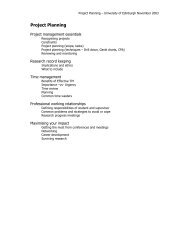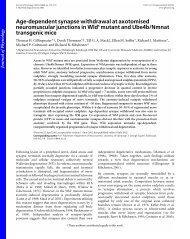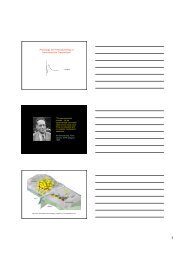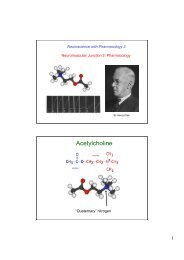Neuromuscular Junction - Pharmacology
Neuromuscular Junction - Pharmacology
Neuromuscular Junction - Pharmacology
Create successful ePaper yourself
Turn your PDF publications into a flip-book with our unique Google optimized e-Paper software.
<strong>Neuromuscular</strong> <strong>Junction</strong> - <strong>Pharmacology</strong>1. Some pharmacological principles, illustrated by ACh at the NMJ2. Targets for drug action at the NMJ3. Drugs affecting synthesis, storage and release of ACh4. Drugs affecting ACh Esterase (inactivation)5. Drugs affecting ACh Receptors (activation)•competitive and depolarising block6. Clinical uses of drugs acting at the NMJReadingRang et al. <strong>Pharmacology</strong>http://www.dns.ed.ac.uk/~rrr/NWPrrr.html
General Principle of <strong>Pharmacology</strong>: 1Most drugs are effectivebecause they bind to proteins : Enzymes Carriers Ion channels Receptors
General Principle of <strong>Pharmacology</strong>: 2Drugs are useful as: Experimental tools Clinical treatments
General Principle of <strong>Pharmacology</strong>: 3The concept of the receptor, and mostkinds of receptors, have been identifiedby the selective effects of specific drugs
General Principle of <strong>Pharmacology</strong>: 4Drug assays are based on: Ligand binding (->affinity, K A ) Biological response (->efficacy, EC50)
General Principle of <strong>Pharmacology</strong>: 5When “doing drugs” a good pharmacologist needs to know:•Target specificity/Ligand specificity• Agonist/Antagonist• Dose/Response• Affinity (K A )/Efficacy (EC50)• Competitive/Non-competitive• Clinical/Non-clinical uses• Side-effects
In neuromuscular pharmacology, the targets are:SynthesisStorage Release Action Inactivation
The biological responses normally measured in skeletalmuscle are: muscle contraction (twitch/tetanus); transmitter release (EPCs/EPPs); receptor response (nAChR channels) ion channel function (Action potentials/Na or K channels)
0 Ca Direct +Ca +4AP +Mg +4AP DirectTTX
XAction potential…add µ-conotoxin…add d-tubocurarine
EPPs in µ-conotoxin/d-tubocurarineEPP in low Ca/high MgMg 2+Ca 2+5 mV10.00 ms5 mV10.00 ms
Ligand-gated(eg AChR)Na +Voltage-gated(e.g. NaV)Na +ACh+ +K +
V-gated Ion-channel <strong>Pharmacology</strong>ChannelNa channelsAntagonist/blockertetrodotoxin (TTX)saxitoxin (STX)µ-conotoxinlignocaineK channels Cs +tetraethylammonium (TEA)4-aminopyridine (4-AP)Ca channels Cd 2+ , Mg 2+N-typeω-conotoxinP-typeω-agatoxinL-typedihydropyridines (DHP)
Acetylcholine+Quaternary nitrogen
K channel blockers and some toxins enhance transmitter releaseα-latrotoxin7.06.56.05.55.04.54.03.51ACmV3.02.52.01.51.00.50.0-0.5-1.0-1.50 50 100 150 200 250 300 350 400 450 500 550 600 650 700 750 800 850 900 950 1000 1050 1100 1150 1200sBEFOREDuringAFTER
Drugs that inhibit transmitter synthesis/storageCholine uptakexxVesicle filling
Drugs that inhibit transmitter releaseCa 2+ channel blockersBotulinum toxins = ‘SNARE’ blockersCa 2+xx
Drugs that block ACh esterasexAntidote:
The “nicotinic” ACh Receptorδαεαchannel poreβACh binding
General scheme for Agonist-Receptor InteractionACh + R ACh-R ACh-R*boundactivatedACh-R 0“desensitized”
Drugs that stimulate ACh Receptors (agonists)
Drugs that block ACh Receptors (antagonists)
Atropined-Tubocurarine
Drugs that block ACh Receptors (antagonists)Example:d-tubocurarineExample:α-bungarotoxin
Drugs that block ACh Receptors (antagonists)Controlα-bungarotoxin10µm α-BTX
xACh antagonists that are used clinically
SuxamethoniumAcetylcholine22 Not broken down by AChE (nmj) Broken down by BuChE (blood plasma) Short lasting Not counteracted by cholinesterase inhibitor Used clinically for brief muscle relaxation “Depolarising blocker”
dTC dTC neo sux sux sux neo direct
Na + Na +SuxK + + +
Na +Na +Sux+K + +
Na + Na +Sux+K +
SuxNa +SuxK +
nACh Receptor <strong>Pharmacology</strong> - <strong>Neuromuscular</strong> <strong>Junction</strong>Agonist Antagonist/blocker Cholinesteraseinhibitorsnicotine d-tubocurarine (curare) parathionacetylcholine α-bungarotoxin sarincarbachol atracurium ecothiopatedecamethonium pancuronium edrophoniumsuxamethonium (I) suxamethonium(II) neostigmine
Targets of drug action at the neuromuscular junctionvesamicolbotulinium (A-D)hemicholiniumα-bungarotoxind-tubocurarineatracuriumsuxamethoniumedrophoniumneostigminesarin
Summary1. Drugs with effects on neuromuscular synapses may be tested in many ways: bioassayof muscle contractions, iontophoresis during intracellular recording; or patch-clamprecording from single receptors and channels2. Every step in the cycle of ACh synthesis, storage, release, activation and inactivationis a potential target for drug action at the NMJ.3. Drugs affecting storage and release:•4-AP, TEA, latrotoxin, botulinum toxin, agatoxin•hemicholinium, vesamicol4. Drugs that block ACh Esterase:•edrophonium, prostigmine, neostigmine, sarin5. Drugs affecting ACh Receptors:•carbachol, decamethonium, suxamethonium•tubocurarine, a-bungarotoxin, atracurium6. Clinical uses of drugs acting at the NMJ:•muscle relaxants as adjunct to anaesthesia in surgery•treatment of neuromuscular disease








